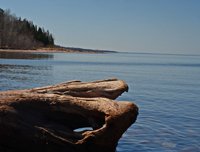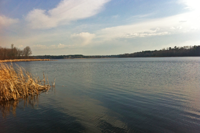Fishrapper Fishing Reports For April 2015
|
Helping your fellow ice fishermen and women stay abreast of the ice conditions in your area is good for everybody and it's easier than you think! Fishing Reports Minnesota is the Facebook counterpart to this page and it's open to the public. So be like me, become a duly deputized "Cub Reporter" and post your own pics and comments. It's good for fishing! Follow link to >> Fishing Reports Minnesota |
 |
 Fishing Report April 17, 2015 - Walleye Spawning Run At Cutffot Sioux
Fishing Report April 17, 2015 - Walleye Spawning Run At Cutffot Sioux
Imagine waking up for your morning coffee with a couple of thousand Walleyes staring you in the face; we should all be so lucky! For some of the DNR Fisheries Staff, that scene is a reality for a week or so each spring.
Walleyes everywhere begin answering their urge to spawn shortly after ice out, when the water temperatures begin rising into the low-mid 40 degree range. Guided by instinct, they move toward a variety of spawning areas, on a variety of lakes, in this case ... Read >> Cutfoot Sioux Walleye Egg Harvest
 Fishing Report April 15, 2015 - Ice Out; Providing Plenty of Room for Fish ... To Hide!
Fishing Report April 15, 2015 - Ice Out; Providing Plenty of Room for Fish ... To Hide!
You might be thinking, oh ho hum, here he goes again, another sob story about how the fish wouldn't bite. Well, if I wanted to look at that way, I could probably spill a few tears while I scramble to come up with some fancy excuses about spending 8 hours on the water this Tuesday without catching any fish; I could ...
But I Know that You Know that I don't see things that way! Instead, You Know that I'm gonna come up with something nice to say about that fishless trip no matter what.
For I and Cub Reporter, Staff #004, AKA Arne Danielson, the original plan was to drive north to wrap up the Rainy River season with one last try for a big Walleye.
That was before I started getting ideas about all of the open water that we have here, in our own back yard. So at the last minute, I asked for a day to do some experimental fishing. Apparently it was a little bit too experimental because the fish never did figure out that we were trying to catch them. Some of the ideas really should have panned out because we actually did find fish. They didn't bite though, maybe our timing was just too quick for them, and they just were not ready.
I'll bet I won't get any argument from #004 though, in spite of the fish be too tough to tackle, there was just something so nice about futzing around on "home water" under Blue skies and calm winds.
Our first stop was at Pokegama Lake in Grand Rapids which was almost completely ice free. In fact we were able to navigate from the Tioga Landing almost all of the way to the Hwy. 169 Bridge. That's where we came upon last 1/4 mile of ice cover in the main lake. That ice was soft, easily penetrable and by today, it’s probably already gone. There were some other loose patches of ice floating around out there, but they were even softer and we navigated (slowly) right through a couple of them.
After trying some deep water, some shallow water and then some deep water again, we decided that Pokegama was gonna have to wait. We trailered up to the Mississippi River between Grand Rapids and the Pokegama Dam.
On the river, we looked at deep water, shallow water, then deeper water and the even shallower water, but we just could not find any sign of life except for one small Northern who came along and messed up my perfect record.
So experimenting with the experimental didn't fill the fish cooler, but I don’t think that it mattered that much. For us, it was a great day, we solved at least half of the world problems and I'll bet if you'd been there, we’d have solved even more! I’m sure that you would have agreed, fish or no fish, it definitely was a Beautiful Day!!
Fishing Article: Ice Out Bass Fishing Tactics on Northern Rivers
For most of us, early spring fishing conjurs up images of Walleye, Crappie and Panfish. But Bass fishing is a blast too and there are plenty of spots where you can fish in complete privacy.
If you struggle to catch bass or think it's too cold to fish for bass when the ice first melts off your local river, think again. It can be some of the best bass fishing of the whole year. Read Tom Monsoor's tips for bass fishing as soon as the water becomes wet up north. Learn More >> Ice Out Bass Fishing Tactics on Northern Rivers
 Fishing Report April 14, 2015 - Watching The Watchable Cutfoot Sioux Walleye Egg Harvest?
Fishing Report April 14, 2015 - Watching The Watchable Cutfoot Sioux Walleye Egg Harvest?
Curious to see if my suspicions were right, I drove up to the bridge at Little Cutfoot Sioux on Monday to see if DNR fisheries staff had assembled the infrastructure for the Walleye egg harvest. Sure enough, there it was, headquarters central was all set up and almost ready for prime time. The nets will probably be set sometime today at the Walleye Egg Harvest Station. The first wave of spawning Walleyes may even arrive during the wee hours tonight; maybe we'll be looking at some fresh photos of the operation by Thursday morning. Folks interested in a casual peak at the operation can see the setup from the Hwy 46 Bridge located 18 miles NW of Deer River. But if you want to get in for a closer look, you can, but don’t attempt to go in through the resort at the bridge.
From Hwy 46, follow the road into the O-Ne-Gum-E Campground that is located less than a mile south of the Little Cutfoot Sioux Bridge. The access road winds through the campground and then north to the egg harvest site. The DNR Fisheries Staff is typically very welcoming, but if you happen to show up during the heat of a harvesting session, be sure to give them plenty of room to move around; timing is crucial during the harvest.
Click here for a map to >> Cutfoot Sioux Walleye Egg Harvest Site
 Fishing Report April 14, 2015 Lake Winnibigoshish Icing Out Early
Fishing Report April 14, 2015 Lake Winnibigoshish Icing Out Early
Anglers are going to need something new to talk about this spring, the ice won't be around to entertain us much longer. After enjoying the past couple of seasons on pins and needles about whether Winnie would be ice free in time for the Walleye fishing opener, this spring it's a non-factor.
On Monday, northwest winds were blowing whitecaps from Tamarack Bay into the Dam Bay. Ice was piling up along the shoreline between Plughat Point and Sunset View Resort and from there, I could also see ice piled up at Tamarack Point and along Bowens Flats. I'm guessing that the view from Mallard Point north into the 3rd River Flowage probably included a lot of open water and You Know what happens next; a wind shift sends the remaining ice that direction and then the rest of the ice disappears in a flash.
 Fishing Report April 13, 2015 - Watching The Watchable Cutfoot Sioux Walleye Egg Harvest?
Fishing Report April 13, 2015 - Watching The Watchable Cutfoot Sioux Walleye Egg Harvest?
On April 6th, my friend Kevin Scott wrote; "When we were fishing last year, we talked about the DNR egg harvest on Cutfoot. Is there anyway a guy could come up and watch and if so when?
A) Kevin, Yes, the public is allowed to visit the operation to see how the Walleye Egg Harvest works. As of Sunday April 12, the ice on Little Cutfoot Sioux was gone. This means that DNR Fisheries staff will likely be setting up gear at the site during the next couple of days. I'd be willing to bet that before next weekend, the nets we bill in place and the Walleye Egg Harvest will be chugging along at full throttle.
For anyone who would like to pay the fisheries staff a visit and watch the egg harvest in progress, you'll need to be ready to hop in the jalopy when the action is about to peak. I can help make that date a little more predictable by providing an update every day this week.
Check the report every day; keep your gas tank full and your camera batteries charged up, the action will begin very soon.
 Fishing Report April 10, 2015 - Grand Rapids Area Lakes Icing Out
Fishing Report April 10, 2015 - Grand Rapids Area Lakes Icing Out
Grand Rapids area lakes are losing their ice so fast that I'm thinking I may be able to put my boat in the water next week. Actually, if I wanted to fish on the Mississippi River right now, I already can; the entire stretch of river between Grand Rapids and Deer River is already wide open, so are the public landings. Pokegama’s small bays are already accessible too, but a boater would not be able to navigate the main body of the lake. Portions of Jay Gould, Little Jay Gould and ... read >> Grand Rapids Lakes Ice Out
 Fishing Report April 9, 2015 - Rainy River's Cold Water, Pre-Spawn Walleyes
Fishing Report April 9, 2015 - Rainy River's Cold Water, Pre-Spawn Walleyes
Cold water temperatures and slow current flow persist on the rainy river, giving anglers a challenging set of circumstances. Not all of the news is discouraging though, in spite of the cold conditions, some of Lake of the Woods' Walleyes are responding to their urge to spawn, advancing into the Rainy River, albeit more slowly than most anglers prefer.
They are coming; the spawning event is inevitable, the only question is whether or not the lion's share of the fish will make their way into the river before the April 14 season closing.
On Wednesday, I and my fishing partner Arne Danielson, AKA Cub Reporter, Staff #004, made our way to the Rainy River. As we drove toward Baudette on Hwy 11, we noticed that the Timber Mill Park landing was less than 1/2 full and soon discovered why. The Wheelers Point Landing has now become the center of attention for likeminded anglers who had intentions of getting as close to the gap as possible. The parking lot at Wheelers Point was filled and there were a couple of dozen rigs already parked along the road side. Still, the traffic wasn't heavy enough to cause discomfort and getting on to the river was accomplished easily.
It makes sense that everyone would show up here, the fish have been slow to arrive in the river and most of us were trying to get as close to the big lake as we could. That way we'd have an early chance at presenting our baits to the early arrivals, before they make their way further upstream where the spawning typically occurs.
I have to admit that I was a bit out of my element, I don't typically fish on this stretch of river, so I had to do some head scratching about which way to go. From the landing, it was hard to see where most of the fishermen had gone. The water downstream from the landing was occupied with a few boats, but not enough to account for all of the traffic at the ramp. Upstream wasn't that busy either, there were only small, scattered groups of boats separated by miles long stretches of wide open territory.
We had learned that the river is wide open all the way out to the gap at Lake of the Woods. Maybe that's where a lot of the traffic went, I was curious and would have liked to have gone out there; but the air temperature was 34° and it didn't seem necessary to make that long of a run. Instead, we just started moving slowly upstream watching the sonar and Lakemaster chart for clues about where to start.
As we trolled, we noted the surface temperature was still a very cold, 38°. Slow river flow persists too and without a wind, we could drift with the current to get an accurate speed. Drifting unassisted, the river current only moved the boat at .3 to .4 MPH, perhaps the slowest I've ever experienced.
I spotted a shallow sand bar that lay adjacent to a depression in the river. According to the chart, the deepest portion of the hole was in Canadian territory, but the breakline along the edge of the sand bar was located in fishable US territory. We started fishing at the upstream edge of the sand bar and slowly trolled downstream in water depths of 12 to 15 feet of water. It didn't take all that long for Arne to put us onto the scoreboard with a nice 19 inch Walleye. We followed up with a couple more fish, but the action at this spot fizzled out and we moved a couple of miles further upstream.
Spot #2 fizzled out before it started, we didn't catch anything there, but I could see another hole/sand bar combination on the chart. Trolling along the edges of the sand bar in 15 feet of water, I could not see fish on the sonar at all. But when I switched over to the side imaging, I could easily see fish along the shallow edges of the bar. Apparently the fish were holding so tight to the bottom that the sonar could parse their images from the bottom. The side images revealed them though and it is the only reason that we stopped here to fish, luckily we did!
I don't want to make it sound too good, but it was good enough for us guys; slow but steady action for a couple of hours. The fish were mainly females, showing up in small packs that produced short spurts of action. We missed some of our strikes, but for the most part, these fish struck with enough enthusiasm to allow us good hook sets.
We stuck with the presentation that we'd used last weekend, 1/4 ounce jigs tipped with Rainbow Chubs. For me, a Glow/Pink Lindy Jig was the best, for Arne, a 1/4 ounce Glow/Blue collector’s item. Giving the jigs a short hop by twitching the rod tips seemed to help attract fish and trigger them to strike. We weren't ripping or snapping the jigs aggressively, just making them hop sharply off of the bottom, 3 or 4 inches at a time.
I kept my boat speed slow, .5 MPH or less at all times, which was easily accomplished using the MinnKota at the lowest settings. If fact, we were able to fish the edge of the sand bar in both directions, almost like we were fishing the breakline on a lake, instead of a river.
Shortly before we left, the action had fizzled out at this spot and we decided to try one more pass at our first hole. Lucky we did that too because that's where Arne picked up our largest fish of the day, a plump 27 inch female who was making her way to the spawning grounds.
The surface temperature had only risen to 38.6° by about 6:30 in the evening when we headed for home. With a warm up on tap for this weekend, a few fish moving up stream and lots of open territory, I think your chances for catching some fish are good. If you consider the odds of catching a 30 inch Walleye any other place in Minnesota, it's hard to pass up an opportunity. By the way, it is doable for you; there are some 29, 30 and 31 inch fish being caught up there right now, so the idea is not as farfetched as you may think.
Here's one parting thought about searching for fish up there right now. We saw lots of folks running and gunning, searching for the "hot bite". MOST OF THEM stopped, fished for 15 minutes and then took off again without catching anything. Take it from me, an expert at waiting, I think that this is one of those times when testing your own patience and slowly working on a good stretch of water is the best bet. Sometimes being determined to win and knowing that you will is the only thing that separates the leaders from the followers.
 Fishing Report April 8, 2015 - Rainy River Re-Match Today
Fishing Report April 8, 2015 - Rainy River Re-Match Today
I'm looking at both the weather forecast and my calendar; the weather gets better this weekend, but for me, the calendar gets worse. So if I have any intention of trying to catch a gigantic pre-spawn Walleye this season, it appears that I either have to do it today, or take my chances that conditions will be good on April 14th for the season wrap up.
Hmm, tough decision, but under the circumstances, I think there's only one reasonable thing to do. I'm doing it all for you, I'll sacrifice my own warmth, go there today and get you a firsthand fishing report. Yes, that's it, today is the day and I think my chances are good because I just got word that the river is open almost all of the way out to the gap at 4 mile bay. For every mile of open water, there’s more “fresh fish” and fewer boats to argue over available space.
Along with the added space, more open water means that large female Walleyes will be encouraged to move into the river where they’ll be staging for the big event.
The weather forecast for today isn’t perfect, but there is a slight warming trend coming our way and there won’t be much wind to fight either. Sunshine, 45 degrees and a 5 MPH breeze; I think we can handle that. Whatever happens, you Know that You will be the first to Know!
 Fishing Report April 7, 2015 - Rainy River, Walleye Run 2015
Fishing Report April 7, 2015 - Rainy River, Walleye Run 2015
On Monday, I wrote; "An egg is and egg, they take a certain amount of time to develop and whenever they are mature, the females will move ahead with their plans." It was my own comments about Walleye spawning piqued my interest, I wondered about when the eggs really are ready and what conditions finally triggers the spawning run?
I decided to call in an expert, MN DNR Large Lake Specialist, Gerry Albert. Albert supervises the Walleye egg harvest at Cutfoot Sioux and he’s been there every spring for a long time; if there’s anybody who knows what goes through those fishes minds, it is him.
The question I asked was simple; what set of conditions actually trigger spring spawning runs and can we estimate when they will occur?
First we looked back at the behavior of spawning Walleyes during that odd 2012 season, the one where ice out at Cutfoot Sioux occurred on the earliest recorded date.
That spring, the DNR fisheries staff was at the top of their game, they had all of the nets set, the harvesting gear was ready for action and the heat was on at the hatchery. Then, instead of enjoying an early spawning run, they watched empty nets do nothing but take up space for a full 10 days before the Walleyes decided it was time to mosey in. So if the ice was out and the water was warming, why didn’t the fish show up? They did, but they did it when THEY were ready.
Theories get kicked around and we all have a few of our own, but after talking with Mr. Albert, I like this explanation the best.
We already know that there is no single event that by itself triggers the fish to begin moving. The main ones that work in unison though are length of daylight, water temperature and current flow.
Food is consumed, especially during the pre-spawn stage, but unlike the rest of the season, eating in not the main focus of these spawning fish. They feed as they travel, but the instinct to re-produce trumps everything else, including food during the spawning runs.
Water temperature is important, we all know that, but I learned something new yesterday. Warmer water doesn’t just encourage fish to move because it’s warmer, warming water temperatures are also part of speeding up the development of the eggs. It makes sense, a chicken sits on her eggs to warm them up, and that’s what makes them hatch. But a fish can’t do that, cold blooded; they have to depend on the entire body of water to warm up. When water temperatures rise quickly, the eggs mature more quickly and the spawning runs tend to be more intense.
That goes a long way toward explaining what’s happening on the Rainy River right now. The water is just too cold to trigger a full scale spawning run. In spite of enjoying an early ice out, the outside temperatures remain cold and water levels are very low. During a typical spring, the current flow from small rivers and feeder streams would typically help warm the water of the river’s main channel. The warming trend would speed up the whole process, including the development of the Walleye eggs and we’d be enjoying better fishing sooner.
So what this means for us river watchers is that the sandglass is trickling, the Walleyes will show up. The question is will they show up before April 14th or afterward?
I think that some of the female Walleyes are moving already, most of the fishermen up there are catching a handful of fish each day. As water temperatures push above 40 degrees, activity will increase and for anglers who tough it out until the last days of the season, there will be a reward.
![]() Fishing Report April 6, 2015 - Rainy River, Easter Weekend Update
Fishing Report April 6, 2015 - Rainy River, Easter Weekend Update
As expected, Easter weekend Walleye fishing action on the Rainy River was on the slow side. But for folks like me, who just needed an excuse to get outside and do something, it was good enough.
I didn't want to consume my Easter Sunday by going off on a rant, but today, I don't mind telling you that I'm little bit concerned about something. It has to do within an attitude toward fishing that seems to be getting more prevalent, the idea that unless one bags a whole bunch of fish, the excursion is time wasted.
On Saturday, we fished from 1:00 PM to 5:00 PM and caught a total of 9 fish. My oldest child caught a 23 inch Walleye, 2 keepers in the 18 inch range and a couple of little guys. Austin Jones caught one nice keeper and a couple of little guys and me, well I only caught one fish, but it was a good one and if you know where to look, you'll be seeing me with it.
Okay, so what I'm trying to say is that the attitude of most of the fishermen I've talked to is that they wouldn't want to waste their time to make that trip for such a slow day.
Hmm.. I'm still trying to find the section in the book of Walleye fishing that says fishing is only good when you catch 50 fish a day. For us, the expectations were low to begin with, so I didn't feel any pressure to find fish by the tons. Besides, I had two of my favorite people in the whole world with me and they teamed up to produce plenty of fish for a really nice fish fry for the whole family; so what's wrong with that?
On the technical side, there are some reasons that the fish have not shown up in large numbers yet. Low water temperatures, slow moving current and the failed shiner run of last fall have teamed up to discourage Walleyes to run en masse into the river.
This reminds me of the scenario that occurred in 2012 when we experienced the earliest ice out on record at the Cutfoot Sioux egg harvesting station. That spring, the DNR anticipated an early spawning run and had everything set up set well ahead of the usual starting time. But the early run didn't come, in spite of the open water and warm temperatures, the fish didn't move until they were ready. When the time was right and the eggs were ready, the movement was fast and furious and the entire harvest was completed in only a few days.
An egg is an egg, they take a certain amount of time to develop and whenever they are mature, the females will move ahead with their plans. After that, the males will follow and soon after that, we can expect faster fishing action.
On Saturday, the surface temperature on the river was 38.7° and the current flow was very slow. I had estimated maybe 1 to 2 MPH, but the wind was blowing us upstream and that made it impossible to judge accurately. I actually had to use the MinnKota to make the boat troll downstream; otherwise we just sat in one spot.
The fish were holding in 22 to 24 feet of water, along the edges of the deepest holes in the area. So because of the slow current, heavy weight were not required, our best presentation was a quarter ounce Lindy Jig tipped with the rainbow and fished very slowly just above the bottom. There was very little action required to get a fish to strike, a steady lift and settle was all it took to keep the bait in the strike zone.
For us, glow colors are always a good choice on the river and in this particular instance glow and pink two toned jigs turned out to be our favorites for the day.
I already Know that You Know what I'm saying. It's true that we didn't pile fish up to the gunnels, but I still felt bulletproof; nothing could go wrong, nothing could go bad and even if the action was slow, look at where I was and who I was with; for me, the fishing was fantastic.
I wouldn't mind hearing that sentiment echoed a little more often.
![]() Fishing Report April 4, 2015 - Rainy River Here We Come
Fishing Report April 4, 2015 - Rainy River Here We Come
According to what most of my friends have already told me, we shouldn't be expecting to find any sort of a "hot bite". But with the whole family in town for Easter and no reliable ice fishing spot to visit, the river is the only game in town for today. So in spite of the discouraging reports from the northern border, we are going to pack up truck and head for the Rainy River today. Sometimes a guy just has to go see for himself, right?
By tonight, I'll have some fresh pics of something and maybe with a little luck, we'll even have a few fish to show for the effort. One thing I do know, it's gonna be a heck of a lot better than sitting inside! So have a great day and stay tuned to see how the day unfolds.
I'm pretty sure that these pictures say enough about the current ice conditions. It was a nice season, we caught a lot of fish and it's all behind us. Now it's time to look forward to warmer days and the sounds of summer. If you want to, you can read more about >> ice conditions here .
For me, the family is beginning to gather and once they all arrive, our next stop
will be a fishing trip on the Rainy River this Saturday. Friends are on their way to river right now and with luck, we'll have some good, first hand reports for you during the wee-hours Saturday morning.
 Fishing Report April 2, 2015 - Afternoon Ice Update - If You're Not Here Already, Don't Come.
Fishing Report April 2, 2015 - Afternoon Ice Update - If You're Not Here Already, Don't Come.
It's 1:30 PM and my fishing buddy, Bill Powell and I are just in from a 2 hour tour of the Bowstring and Lake Winnie area. There were two of us on the mission, so that means that we officially qualify as the proverbial "Panel of Experts". So it is with certain authority that I'm reporting that the consensus is that ice fishermen, who are already here, will probably enjoy their day today. After that, we believe that finding a safe place to access the ice will be nearly impossible.
During the trip we stopped at Lake Winnie's Tamarack Bay, Plughat Point and Bowen's Flats. Then we checked William's Narrows on Cutfoot Sioux, Little Cutfoot Sioux and both the north and northwest landings on Bowstring Lake. Of all the stops that we made, the only place that we felt safe walking on the ice near shore was at the poacher's landing at Bowen's Flat at Winnie.
All of the other landings that we looked at were either already opening up or on the verge of opening. In fact, there were a couple of places where we questioned whether or not the anglers, who are on the ice now, will be able to safely return later this afternoon.
If you're thinking that maybe smaller waters would provide a better opportunity, forget all about that idea. The smaller lakes, especially the dark water
ones are even closer to ice out. Open water along the edges, slushy, unstable ice near shore and black ice in the middle all add up to ice out sooner, not later.
Sunshine, strong winds and warm afternoon temperatures are going to accelerate the process even more. So to reiterate the main point, if you had plans to make a long drive to go ice fishing on Friday or Saturday, we believe that the odds are that you'll be disappointed when you arrive.
Okay, so now that we have that out of our system, we can focus on Walleye fishing the Rainy River.
If you don't know already, there is now open water all of the way
past Baudette and all of the landings are open. Open water is advancing rapidly toward the lake and it's conceivable that fishermen may even be able to access the gap before the fishing season ends on April 14th.
Right now, fish are being caught, but the action is far from fantastic. For anglers who put in their time, modest catches of mostly male fish are being reported. Soon, spawning will drive the movement of larger females and they will begin showing up in the river in good numbers.
The full moon is scheduled for this Saturday and that could be the catalyst for a major movement. We we all know how that works out very soon.
 Fishing Report April 2, 2015 - Ice Fishing For Easter? It's Still Do-Able, If You Know Where
Fishing Report April 2, 2015 - Ice Fishing For Easter? It's Still Do-Able, If You Know Where
Okay, so you want to go ice fishing one more time and you're wondering where to go. Well thanks to to handy work of Cub Reporters, Staff #004 and #005, we have enough pictures of "good accesses" to convince me that in terms of safety, it is definitely doable.
Success stories from ice fishermen are still coming in too and
that even makes me feel like getting geared back up for one more trip onto the ice.
For instance, the image you see here of Tom Blanck who only had to hoof it a short distance from the landing to get in on a fantastic day of "multi species" on the ice. Blanck, along with his fishing crew spent their day fishing over 3 to 4 feet of water and caught Perch, Walleye and Northern Pike; all without even wearing a pair of gloves.
On the north side of Bowstring Lake, ice conditions remain fairly good and IF conditions don't deteriorate overnight, this is probably a viable option for the weekend. Landings on Lake Winnibigoshish, Cutfoot Sioux, Ball Club ... most of the river fed lakes in the region are in fairly good condition.
A word to the wise though, conditions are changing fast and what you see today, might not be there tomorrow. That's what happened on Little Cutfoot; I saw fishermen standing on the ice, fishing for Panfish on Tuesday. But on Wednesday, Cub Reporter, Staff #004 stopped at the landing and snapped a photo of what is now an un-useable landing; his photo caption read "It's even worse than it looks".
I deliberately singled out river fed lakes when I mentioned landings that are in fairly good shape. My theory is that the water levels are so so low right now that there isn't enough moisture under the ice to errode these landings. That would go a long way toward explaining why some of the Grand Rapids area lakes are melting so fast, while others appear to be locked up tight.
Hungry for more information, ice fishermen have been burning up the phone lines at local bait shops and for that reason, I'm on my way to pick up Cub Reporter, Staff #006 and we're going out on one more photo tour. In the meantime, if you are among the folks who wants to squeeze in one more ice fishing trip, you can do it this weekend.
Plan on walking to the fishing spots, but bring your 4 wheeler just in case you stumble in one of the landings that provide better than average opportunities. I have to say this to cover my whatchamacallit, so please don't take it personal, bu remember, it is not legal to drive your 4 wheeler in the water, not even to cross the shallow sand at the landings. So if you decide to venture out onto the lake with your 4 wheeler, be sure to find a dry spot.
Okay, so we're on our way out the door, we'll do our best to cover some of the more popular accesses. Please check back again later for more images of the lake landings.
![]() Fishing Article Using Side Imaging To Produce Pre-Spawn Walleyes
Fishing Article Using Side Imaging To Produce Pre-Spawn Walleyes
Pre-spawn walleyes respond to this burst of icy cold water in predictable ways. First of all, recognize that the fish don't move (or, don't move very far). Biology and instinct has driven them to position on or very near spawning areas, and those biological urges have not disappeared. Unless the dip in water temperatures is also accompanied by an unusual, dramatic increase in water flow, the fish will typically not reposition within the river. That's the good news: if you knew where the fish were in late winter, then you know where to focus your efforts when the water ... read article >> Dr. Jason Halfen, Side Imaging For Pre-Spawn Walleyes .
![]() (4/2) From Lake of the Woods, Sportsmans's Lodges; "Birchdale, Frontier and now Vidas landings are all open! Open water should be to Baudette in a few days. The weather forecast looks much warmer this week. We should make some good progress opening the river up! Nice sturgeon and walleyes are being caught. Bite is picking up by the day and the warmer weather should help too! Best approach for walleyes right now is a 3/8-1/2 oz. gold or chartreuse jig tipped with a minnow. Sturgeon, #5 hook, 2-5 oz. weight and a gob of night crawlers has been working best in deep crevices of the river bottom. For pike, casting buck tails and assorted flashy spoons work well in weed beds and open bays". - For reservations call 800-862-8602 and let the fun begin!
(4/2) From Lake of the Woods, Sportsmans's Lodges; "Birchdale, Frontier and now Vidas landings are all open! Open water should be to Baudette in a few days. The weather forecast looks much warmer this week. We should make some good progress opening the river up! Nice sturgeon and walleyes are being caught. Bite is picking up by the day and the warmer weather should help too! Best approach for walleyes right now is a 3/8-1/2 oz. gold or chartreuse jig tipped with a minnow. Sturgeon, #5 hook, 2-5 oz. weight and a gob of night crawlers has been working best in deep crevices of the river bottom. For pike, casting buck tails and assorted flashy spoons work well in weed beds and open bays". - For reservations call 800-862-8602 and let the fun begin!
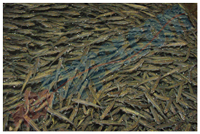
Spottail Shiners will be on hand for the 2015 Walleye opener.
For the 2015 season debut of Fish Ed, Jon Thelen shows us how to catch Missouri River Walleyes.
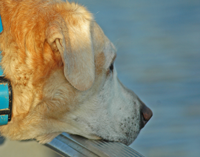
How long are we gonna float around out here pops; you gonna catch something one of these days?
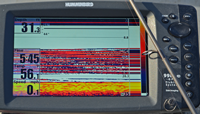
Finding several fairly large groups, suspended from 17 to 25 feet over the lakes deepest water, about 31 feet wasn't that hard. Getting them to bite, was another matter.
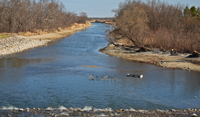
Water levels at the Mississppi River at Lake Winnie ARE LOW.
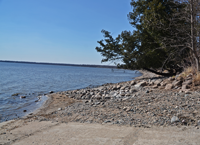
I'm buying into the notion that we better start checking water conditions at our favorite landings in advance. Opening mornings can be, very busy and heightened, jammed up traffic at the ramps is the last thing we need.
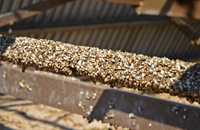
It seems like the news about discovering "Zeebs" in Sand Lake just barely broke, but after only a few seasons, their grip on the lake is very strong.
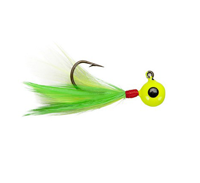
The color of the Little Nipper's feathers adds both buoyancy and extra attracting power. A lively Rainbow Chub, hooked lightly on the outer edges of it's lips provides enormous triggering power too.
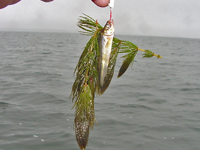
On shallow, sandy flats, newly emerging plants like Coontail and Northern Milfoil provide ideal cover for baitfish. Walleyes roam the flats picking off baitfish.
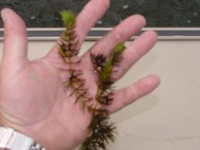
The key to finding a spot like this is to remember places where during mid-summer, these plants choke the flats, making them almost impossible to fish.
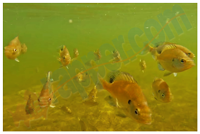
Hungry Sunfish can be devastating to freshly stocked Walleye Fry. Fisheries managers overcome the problem by using fingerlings.
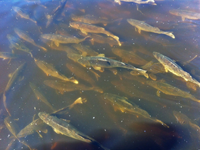
Photo Cub Reporter, Staff #004: Robust Walleye populations at the traps indicate a good season ahead; for the adaptable.
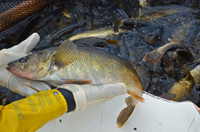
When the water temperatures begin rising into the low 40 degree range Walleye move toward spawning territory. On Little Cutfoot, that's the time for DNR Fisheries Staff to spring into action. Read Article >> Cutfoot Sioux Walleye Egg Harvest
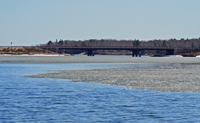
Looking at the Hwy. 169 Bridge on Pokegama, where we came upon last 1/4 mile of ice cover on Tuesday. That ice was soft, easily penetrable and by today, it’s probably already gone.
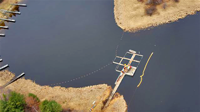
The nets are set at the Walleye Egg Harvest Station. The first wave of spawning Walleyes may even arrive during the wee hours tonight; we could be looking at some fresh photos of the operation by Thursday morning.
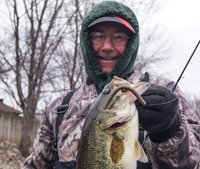
Read fishing artricle >> Ice Out Bass on Northern Rivers
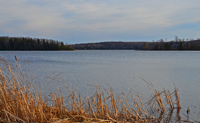
On Pokegama Lake, Grand Rapids small bays are rapidly becoming fishable. Pooles Bay was 70% ice free on Thursday April 9, 2015
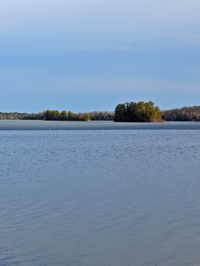
The view from Tioga Beach on Pokegama, Thursday April 9, 2015. I could imagine myself heading for the boat ramp within the next week.
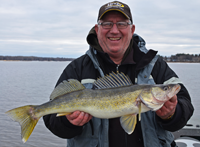
Arne Danielson proving what they say about persitence and a positive attitude. Rainy River Walleye are being caught, but not by the "Runners & Gunners".
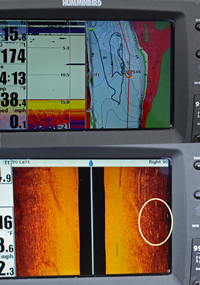
Cold 38 degree water and slow current flow encouraged Walleyes to lay low, disappearing into the bottom. Side images revealed fish that our sonar missed.
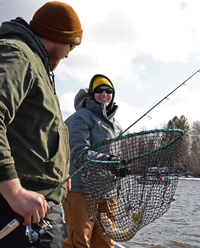
Austin Jones and Annalee Sundin team up to put some "eaters" in the boat this Saturday on the Rainy River.
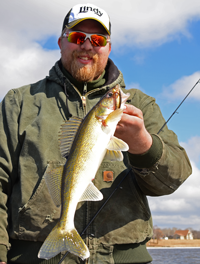
It doesn't take too many 18 inch fish to produce a great fish fry.
April 2, 2015
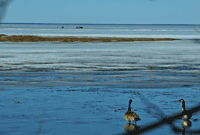
I'll bet you 5 golden goose eggs against your down comforter that they get wet coming back in this afternoon. Whatdaya say, are we on?
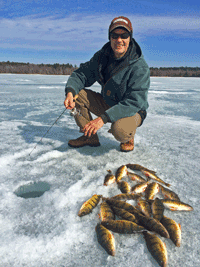
Gathering fish wasn't complicated for Tom Blanck and his fishing crew. Hoofing a short distance from the landing and fishing in shallow water provided plenty of action.
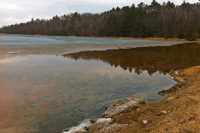
At the Seeleye Landing on Cutfoot Sioux, the ice fishing season is over for this year.
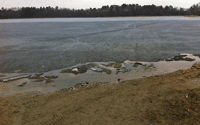
At Little Cutfoot, Cub Reporter, Staff #004 says; "It's even worse than it looks". Ice access is finished here too.
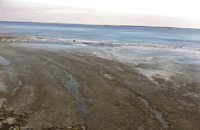
On Bowstring's north end, the landing appeared to be "doable" on Wednesday and will likely hold up throughout the next few days.
"The Early Bird Fishing Guide" Jeff Sundin - Fishing Blue Books, LLC 715 Byington Ave, LaPrairie, MN 55744
Email copyright©2016 Fishing Blue Books, LLC All Rights Reserved - last revised 11-9-16
